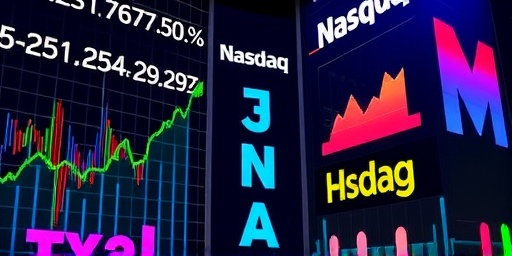In a robust kickoff to November, the S&P 500 climbed 1.2% to close at 5,780 points, while the Nasdaq Composite soared 1.8% to 18,450, marking one of the strongest openings to a month in recent years. This surge was propelled by heightened investor enthusiasm surrounding artificial intelligence (AI) investments, with tech giants like Amazon leading the charge as their shares hit an all-time high of $195.42. The stock market’s positive momentum underscores a broader confidence in corporate America’s commitment to AI-driven innovation, even amid lingering economic uncertainties.
Amazon’s AI Push Propels Shares to Record Heights
Amazon’s performance stood out as the bellwether for the day’s gains, with its stock surging 3.5% on reports of accelerated AI infrastructure spending. The e-commerce behemoth announced plans to invest an additional $75 billion in data centers and cloud computing capabilities through 2025, primarily to support generative AI applications via its AWS platform. This revelation came just days after Amazon’s third-quarter earnings, which revealed a 15% year-over-year increase in AWS revenue to $26.1 billion, largely attributed to AI workloads from enterprise clients.
Analysts point to Amazon’s strategic positioning in the AI ecosystem as a key driver. “The company’s pivot toward AI not only bolsters its cloud dominance but also opens new revenue streams in machine learning services,” said Sarah Jenkins, senior tech analyst at Bloomberg Intelligence. Amazon’s CEO, Andy Jassy, emphasized during a recent investor call that AI investment is “transformative for our long-term growth,” highlighting partnerships with AI startups and integrations in retail operations like personalized recommendations powered by advanced algorithms.
This isn’t isolated to Amazon; the ripple effects were felt across the sector. Shares of AI chipmaker Nvidia rose 2.1%, while Microsoft, another AWS competitor through Azure, gained 1.9%. The collective tech rally contributed over 60% of the Nasdaq’s daily advance, illustrating how AI investment has become the linchpin of stock market vitality.
Investor Sentiment Shifts Toward AI-Driven Optimism
The S&P 500 and Nasdaq’s upward trajectory reflects a palpable shift in investor sentiment, with surveys indicating that 68% of institutional investors now view AI as the top growth catalyst for the next five years, up from 52% earlier in the year. This optimism stems from evidence of sustained corporate spending on AI, despite inflationary pressures and geopolitical tensions. For instance, a recent Deloitte report estimated global AI spending to reach $200 billion in 2024, a 40% jump from 2023 levels, with U.S. firms accounting for nearly half.
Market data supports this fervor. Trading volume on the Nasdaq spiked 25% above average, with AI-related ETFs like the Global X Robotics & Artificial Intelligence ETF (BOTZ) seeing inflows of $450 million in the past week alone. “We’re witnessing a feedback loop where AI hype translates into real capital deployment, boosting earnings and, in turn, stock valuations,” noted Mark Thompson, portfolio manager at Fidelity Investments. The S&P 500‘s technology sector, which comprises about 30% of the index, outperformed the broader market by 2.5 percentage points, underscoring the concentration of gains in AI-centric companies.
However, not all sectors shared in the enthusiasm. Traditional industries like energy and utilities lagged, with the S&P 500 Energy Select Sector Index dipping 0.5%. This divergence highlights how AI investment is reshaping the stock market landscape, favoring innovation over legacy assets. Retail investors, empowered by platforms like Robinhood, poured in $1.2 billion into tech stocks on the day, per Nasdaq data, signaling grassroots confidence in AI’s economic impact.
Broader Economic Context Bolsters Tech Rally
The stock market’s November surge arrives against a backdrop of stabilizing economic indicators that further fuel AI investment narratives. The U.S. Federal Reserve’s recent decision to hold interest rates steady at 5.25-5.50% provided a tailwind, as lower borrowing costs make capital-intensive AI projects more feasible. Inflation cooled to 3.1% in October, per Bureau of Labor Statistics figures, easing fears of aggressive rate hikes that could crimp tech spending.
Corporate earnings season has also played a pivotal role. Of the S&P 500 companies that reported in late October, 78% beat earnings expectations, with AI mentions in earnings calls surging 35% year-over-year, according to FactSet. Amazon’s results were emblematic: net income jumped 48% to $9.9 billion, driven by cost efficiencies from AI-optimized logistics and advertising algorithms. This profitability has assuaged concerns about the sustainability of AI investments, which some critics labeled as speculative earlier in the year.
Globally, the trend mirrors U.S. markets. Europe’s STOXX 600 rose 0.8%, buoyed by AI initiatives from companies like ASML, a key supplier of semiconductor equipment. In Asia, Japan’s Nikkei 225 climbed 1.1%, with SoftBank’s AI-focused Vision Fund reporting fresh commitments. These international echoes reinforce the notion that AI investment is a worldwide phenomenon, amplifying the S&P 500 and Nasdaq’s domestic gains.
- Key Economic Stats: U.S. GDP growth revised upward to 2.8% for Q3.
- AI Spending Projection: Gartner forecasts $110 billion in enterprise AI software by 2024.
- Stock Market Volatility: VIX index dropped 10% to 15.2, indicating reduced fear.
Experts caution that while the rally is AI-led, underlying factors like supply chain resilience and regulatory clarity will determine longevity. The U.S. government’s $52 billion CHIPS Act, aimed at bolstering domestic semiconductor production, is expected to inject further momentum into AI hardware investments.
Expert Voices on AI’s Role in Sustaining Market Gains
Wall Street luminaries are unanimous in their bullish stance on AI investment as the engine behind the S&P 500 and Nasdaq’s trajectory. Goldman Sachs’ chief strategist, David Kostin, projected in a recent note that AI could add $7 trillion to global GDP by 2030, with U.S. equities capturing a disproportionate share through stock market appreciation. “The current surge is not a bubble but a reflection of productivity gains already materializing,” Kostin stated.
From the venture capital side, Sequoia Capital’s partner, Doug Leone, highlighted Amazon’s role in a panel discussion at the Web Summit: “Amazon’s AWS is the backbone of AI deployment, much like the internet’s infrastructure in the 1990s. Their record high is a vote of confidence in scalable AI adoption.” Leone’s firm has backed over 20 AI startups this year, raising $5 billion in funding rounds tied to Amazon’s ecosystem.
Contrarian views exist, however. JPMorgan’s Jamie Dimon warned in his annual letter that AI’s hype could lead to overvaluation if returns don’t materialize swiftly. Yet, even Dimon acknowledged the stock market’s resilience, noting that AI investment has diversified beyond Big Tech to sectors like healthcare and finance. For example, AI-driven drug discovery at Pfizer contributed to a 1.2% uptick in healthcare stocks within the S&P 500.
Quantitative data from Morningstar shows that AI-themed portfolios have outperformed the broader market by 12% year-to-date, with Amazon as the top holding in 45% of such funds. This expert consensus paints a picture of measured optimism, where AI investment is seen as a durable force rather than a fleeting trend.
- Short-Term Catalysts: Upcoming AI conferences like NeurIPS in December could spark further rallies.
- Regulatory Hurdles: EU’s AI Act implementation may influence global standards.
- Workforce Impact: AI job creation projected at 97 million new roles by 2025, per World Economic Forum.
Outlook for AI-Fueled Stock Market Momentum
Looking ahead, the S&P 500 and Nasdaq appear poised for continued gains if AI investment trends hold. Analysts from Morgan Stanley forecast the S&P 500 reaching 6,000 by year-end, driven by 12-15% earnings growth in tech sectors. Amazon’s ambitious roadmap, including the launch of AI-enhanced Alexa devices next quarter, could sustain its momentum and lift peers.
Potential risks loom, including election-year volatility and supply constraints in AI hardware. Yet, with corporate balance sheets flush—S&P 500 companies sitting on $4.5 trillion in cash—the appetite for AI spending remains robust. Investors are eyeing November’s Federal Open Market Committee meeting for hints of rate cuts, which could supercharge the stock market further.
In the long term, AI’s integration into everyday business promises to redefine economic productivity. As Amazon and other leaders scale their investments, the ripple effects could stabilize the Nasdaq and S&P 500 against downturns. For now, the market’s November optimism signals a new chapter where AI isn’t just a buzzword but a bedrock of growth.









